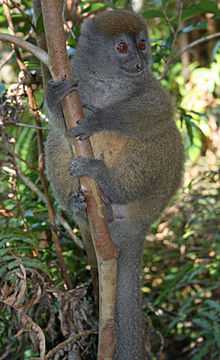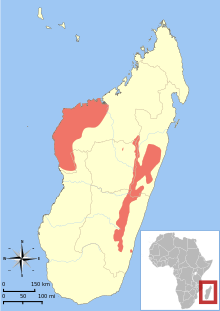Eastern lesser bamboo lemur
| Eastern lesser bamboo lemur | |
|---|---|
 | |
| Conservation status | |
| Scientific classification | |
| Kingdom: | Animalia |
| Phylum: | Chordata |
| Class: | Mammalia |
| Order: | Primates |
| Suborder: | Strepsirrhini |
| Family: | Lemuridae |
| Genus: | Hapalemur |
| Species: | H. griseus |
| Binomial name | |
| Hapalemur griseus Link, 1795[3] | |
| Subspecies | |
| |
 | |
| Distribution of H. griseus[1] | |
| Synonyms | |
| |
The eastern lesser bamboo lemur (Hapalemur griseus), also known as the gray bamboo lemur and the gray gentle lemur, is a small lemur endemic to Madagascar, with three known subspecies. As its name suggests, the eastern lesser bamboo lemur feeds mainly on bamboo. The lemurs of the genus Hapalemur have more manual dexterity and hand–eye coordination than most lemurs.[4] They are vertical climbers and jump from stalk to stalk in thick bamboo forests.
The eastern lesser bamboo lemur is gray in colour, sometimes with a red patch on its head. It averages 284 mm in length with a tail of 36.6 mm.
Subspecies

red = H. g. griseus
green = H. g. ranomafanensis
purple = H. g. gilberti
The eastern lesser bamboo lemur (Hapalemur griseus griseus), also known as the gray bamboo lemur, eastern gray bamboo lemur, or gray gentle lemur, was the original species described in 1795.[5]
Gilbert's bamboo lemur (H. g. gilberti), also known as Gilbert's gentle lemur or Beanamalao bamboo lemur, was described as a subspecies in 2007,[6] but was raised to species status in 2008.[7] In 2010, it was returned to subspecies status.[8] It is known only from the area of Ranomafana-Kianjavato in Madagascar.[7]
The Ranomafana bamboo lemur (H. g. ranomafanensis), or Ranomafana gentle lemur, is the third subspecies.[9]
References
- ↑ 1.0 1.1 Andriaholinirina, N. et al. (2014). "Hapalemur griseus". IUCN Red List of Threatened Species. Version 2014.1. International Union for Conservation of Nature. Retrieved 2014-06-16.
- ↑ "Checklist of CITES Species". CITES. UNEP-WCMC. Retrieved 18 March 2015.
- ↑ Groves, C. P. (2005). Wilson, D. E.; Reeder, D. M, eds. Mammal Species of the World (3rd ed.). Baltimore: Johns Hopkins University Press. p. 116. OCLC 62265494. ISBN 0-801-88221-4.
- ↑ Duke Lemur Center
- ↑ Mittermeier, R.A.; Louis, E.E.; Richardson, M.; Schwitzer, C. et al. (2010). Lemurs of Madagascar. Illustrated by S.D. Nash (3rd ed.). Conservation International. pp. 322–325. ISBN 978-1-934151-23-5. OCLC 670545286.
- ↑ Rabarivola, C., Prosper, P., Zaramody, A., Andriaholinirina, N. and Hauwy, M. (2007). "Cytogenetics and taxonomy of the genus Hapalemur". Lemur News 12: 46–49.
- ↑ 7.0 7.1 Mittermeier, R., Ganzhorn, J., Konstant, W., Glander, K., Tattersall, I., Groves, C., Rylands, A., Hapke, A., Ratsimbazafy, J., Mayor, M., Louis, E., Rumpler, Y., Schwitzer, C. & Rasoloarison, R. (December 2008). "Lemur Diversity in Madagascar". International Journal of Primatology 29 (6): 1607–1656. doi:10.1007/s10764-008-9317-y.
- ↑ Mittermeier, R.A.; Louis, E.E.; Richardson, M.; Schwitzer, C. et al. (2010). Lemurs of Madagascar. Illustrated by S.D. Nash (3rd ed.). Conservation International. pp. 326–327. ISBN 978-1-934151-23-5. OCLC 670545286.
- ↑ Mittermeier, R.A.; Louis, E.E.; Richardson, M.; Schwitzer, C. et al. (2010). Lemurs of Madagascar. Illustrated by S.D. Nash (3rd ed.). Conservation International. pp. 328–331. ISBN 978-1-934151-23-5. OCLC 670545286.
External links
| ||||||||||||||||||||||||||||||
